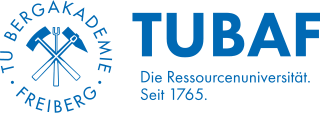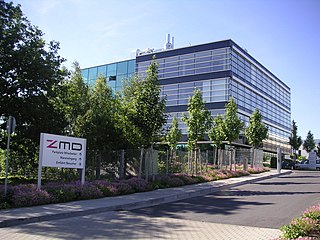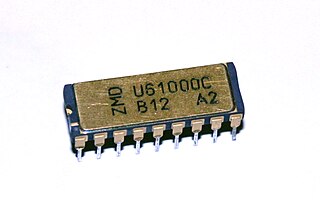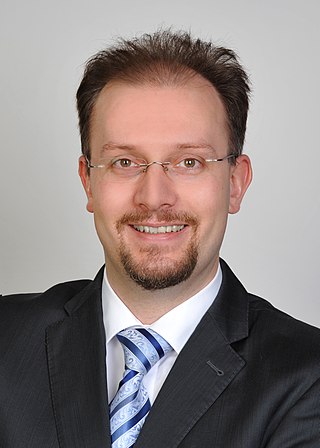The Fraunhofer Society is a German research organization with 76 institutes spread throughout Germany, each focusing on different fields of applied science. With some 30,800 employees, mainly scientists and engineers, and with an annual research budget of about €3.0 billion, it is the biggest organization for applied research and development services in Europe. It is named after Joseph von Fraunhofer who, as a scientist, an engineer, and an entrepreneur, is said to have superbly exemplified the goals of the society.
TU Dresden, also as the Dresden University of Technology, is a public research university in Dresden, Germany. It is the largest institute of higher education in the city of Dresden, the largest university in Saxony and one of the 10 largest universities in Germany with 32,389 students as of 2018.
ISO/IEC 15693, is an ISO/IEC standard for vicinity cards, i.e. cards which can be read from a greater distance as compared with proximity cards. Such cards can normally be read out by a reader without being powered themselves, as the reader will supply the necessary power to the card over the air (wireless).

The Technische Universität Bergakademie Freiberg is a public university of technology with 3,471 students in the city of Freiberg, Saxony, Germany. The university's focuses are exploration, mining & extraction, processing, and recycling of natural resources & scrap, as well as developing new materials and researching renewable energies. It is highly specialized and proficient in these fields.

Chemnitz University of Technology is a public university in Chemnitz, Germany. With over 9,000 students, it is the third largest university in Saxony. It was founded in 1836 as Königliche Gewerbschule and was elevated to a Technische Hochschule, a university of technology, in 1963. With approximately 1,500 employees in science, engineering and management, Chemnitz University of Technology is among the most important employers in the region.

Zentrum Mikroelektronik Dresden (ZMD) was regarded as the heart of East Germany's microelectronics research in the 1980s as well as its most advanced integrated circuit manufacturer. Together with TU Dresden and VEB Spurenmetalle Freiberg, ZMD formed the foundation for Silicon Saxony, a cluster of microelectronics companies that came to include new fabs by Siemens and AMD.

The Berlin-Brandenburg capital region is one of the most prolific centers of higher education and research in the world. It is the largest concentration of universities and colleges in Germany. The city has four public research universities and 27 private, professional and technical colleges (Hochschulen), offering a wide range of disciplines. Access to the German university system is tuition free.

The U880 is an 8-bit microprocessor that was manufactured by VEB Mikroelektronik "Karl Marx" Erfurt in the German Democratic Republic. Production of the U880 started in 1980 at VEB Funkwerk Erfurt. The U880 is an unlicensed clone of the Zilog Z80 microprocessor, also supporting illegal opcodes and bugs, except for very minor differences like not setting the CY flag for the OUTI command.

The X-FAB Silicon Foundries is a group of semiconductor foundries. The group specializes in the fabrication of analog and mixed-signal integrated circuits for fabless semiconductor companies, as well as MEMS and solutions for high voltage applications. The holding company named "X-FAB Silicon Foundries SE" is based in Tessenderlo, Belgium while its headquarters is located in Erfurt, Germany.

The Berthold Leibinger Innovationspreis is an award for given to those who have created applied laser technology and innovations on the application or generation of laser light. It is open to participants worldwide. It is biennially awarded by the German non-profit foundation Berthold Leibinger Stiftung. Three prizes are awarded worth 100,000 euros. The prize winners are selected from eight finalists that present their work person in a jury session. The jury is composed of international experts from different fields.

Werner Hartmann was a German physicist who introduced microelectronics into East Germany. He studied physics at the Technische Hochschule Berlin and worked at Siemens before joining Fernseh GmbH. At the end of World War II, he and his research staff were flown to the Soviet Union to work on their atomic bomb project; he was assigned to Institute G. In 1955, he arrived in the German Democratic Republic (GDR); in the same year, he founded and became the director of the VEB Vakutronik Dresden, later VEB RFT Meßelektronik Dresden. In 1956, he completed his Habilitation at the Technische Hochschule Dresden and also became a professor for Kernphysikalische Elektronik there. In 1961, he founded the Arbeitsstelle für Molekularelektronik Dresden (AME). He was awarded the National Prize of GDR in 1958. In 1974, he was removed from his positions, significantly demoted, and sent to work as a staff scientist at the VEB Spurenmetalle Freiberg. Hartmann had been the object of security investigations by the Stasi for some time; while he was investigated at length and repeatedly interrogated, the alleged charges were politically motivated and no trial ever took place. The Werner-Hartmann-Preis für Chipdesign is an industrial award given in Hartmann's honor for achievement in the field of semiconductors.

The Ferdinand-Braun-Institut, Leibniz-Institut für Höchstfrequenztechnik (FBH) is a research institute, which is a member of the Gottfried Wilhelm Leibniz Scientific Community. The institute is located in Berlin at the Wissenschafts- und Wirtschaftsstandort Adlershof (WISTA), its research activity is applied science in the fields of III-V electronics, photonics, integrated quantum technology and III-V technology
Leibniz-Institut für innovative Mikroelektronik is a German research institute located in Frankfurt (Oder), Brandenburg, Germany. The IHP was founded in 1983 as Institut für Halbleiterphysik, and is today part of the Gottfried Wilhelm Leibniz Scientific Community. The institute has four departments: System Design, Circuit Design, Technology and Materials Research.
The Center for Advancing Electronics Dresden (cfaed) of the Technische Universität Dresden is part of the Excellence Initiative of German universities. The cluster of excellence for microelectronics is funded from 2012 to 2017 by the German Research Community (DFG) and unites about 60 Investigators and their teams from 11 institutions to act jointly towards reaching the Cluster's ambitious aims. The coordinator is Prof. Dr.-Ing. Gerhard Fettweis, Chair of Mobile Communication Systems. The cluster brings together the teams from two universities and several research institutes in Saxony: Technische Universität Dresden, Technische Universität Chemnitz, Helmholtz-Zentrum Dresden-Rossendorf (HZDR), Leibniz Institute for Polymer Research Dresden e.V. (IPF), Leibniz Institute for Solid State and Materials Research Dresden (IFW), Max Planck Institute of Molecular Cell Biology and Genetics (MPI-CBG), Max Planck Institute for the Physics of Complex Systems (MPI-PKS), Nanoelectronics Materials Laboratory gGmbH (NaMLab), Fraunhofer Institute for Electronic Nano Systems, Fraunhofer Institute of Ceramic Technologies and Systems and Kurt Schwabe Institute for Measuring and Sensor Technology Meinsberg e.V. (KSI). About 300 scientists from more than 20 different countries are working in nine research paths to investigate completely new technologies for electronic information processing which overcome the limits of today's predominant CMOS technology.

VEB Kombinat Mikroelektronik Erfurt was an important manufacturer of active electronic components in East Germany. It should not be confused with the more well-known VEB Kombinat Robotron Dresden which used integrated circuits from Kombinat Mikroelektronik in its computers.

East Germany was one of the leading computer producers in the Eastern Bloc as purchases of higher technologies from the West were under various embargoes. A program of illegal purchases, copying and reverse engineering of Western examples was established, after which GDR sold these computers to COMECON countries. Under the rule of Erich Honecker, electronics, microelectronics and data processing industries grew at average 11.4% in the 1970s and 12.9% during the 1980s.
Association football club RB Leipzig-affiliated teams include a reserve team, women's team, and junior and academy teams.

VEB Halbleiterwerk Frankfurt (Oder) (abbreviated HFO or HWF) was the largest manufacturer of semiconductor devices in the German Democratic Republic. In 1989, HFO produced 110 million integrated circuits (70% of all integrated circuits produced in the GDR in that year), 9.7 million transistors, and 150 million transistor chips. Despite this, HFO did not rise to prominence like Zentrum Mikroelektronik Dresden (of megabit chip fame) or VEB Mikroelektronik "Karl Marx" Erfurt (known for its microprocessors). Also unlike Zentrum Mikroelektronik Dresden and VEB Mikroelektronik "Karl Marx" Erfurt, HFO did not survive long after German Reunification.

Jens Lehmann is a computer scientist, who works with knowledge graphs and artificial intelligence. He is a principal scientist at Amazon, an honorary professor at TU Dresden and a fellow of European Laboratory for Learning and Intelligent Systems. Formerly, he was a full professor at the University of Bonn, Germany and lead scientist for Conversational AI and Knowledge Graphs at Fraunhofer IAIS.













